Samsung Galaxy Tab 10.1 Review: The Sleekest Honeycomb Tablet
by Anand Lal Shimpi on June 13, 2011 5:07 AM EST- Posted in
- Tablets
- Samsung
- Tegra 2
- Galaxy tab 10.1
- Android 3.1
- Mobile
- NVIDIA
A Beautiful Display
Other than form factor, the 10.1's display is the only other major advantage Samsung holds over ASUS. While the Eee Pad's display is quantifiably similar to Apple's iPad 2, it does fall victim to an incredible amount of glare. There's a sizable gap between the LCD panel and the outermost glass, which results in more glare than most other tablets we've reviewed this generation. The 10.1 however doesn't suffer this fate and as a result is more directly comparable to the iPad 2.
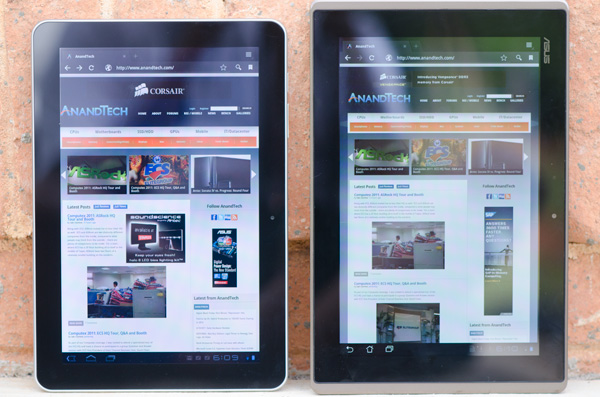
Samsung Galaxy Tab 10.1 (left) vs. ASUS Eee Pad Transformer (right)

Samsung Galaxy Tab 10.1 (left) vs. Apple iPad 2 (right)
While both ASUS and Apple use an IPS panel in their tablets, Samsung uses its own technology called Super PLS (plane line switching). Brian Klug, our resident smartphone and display guru did some digging and it turns out that Super PLS is Samsung's own take on IPS that maintains viewing angle while boosting throughput (brightness). The Samsung supplied photo below shows a comparison of the tradeoff you make with S-IPS and I-IPS, as well as both of those compared to Super PLS:
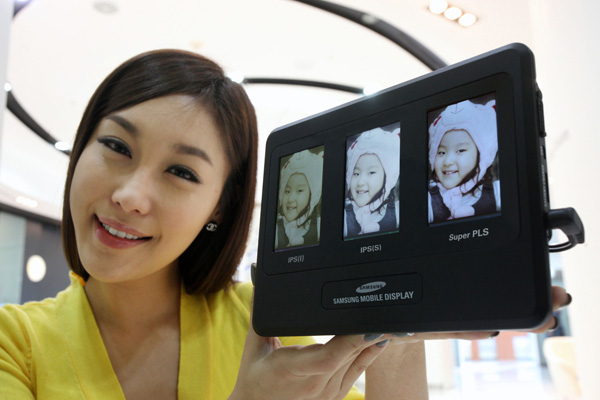
Traditionally you'd have to trade off viewing angle for brightness or vice versa even within the IPS family. Super PLS lets you have your cake and eat it too, giving you the same side viewing angles as S-IPS but with the light throughput of I-IPS.
Perhaps due to the use of Super PLS, Samsung actually managed to outfit the Galaxy Tab 10.1 with a brighter panel than what we saw with the iPad 2. Black levels aren't quite as good but peak brightness is measurably better at nearly 500 nits. While the display isn't what I'd consider bright enough to use in direct sunlight, it is more versatile than the iPad 2's as a result of its brightness.

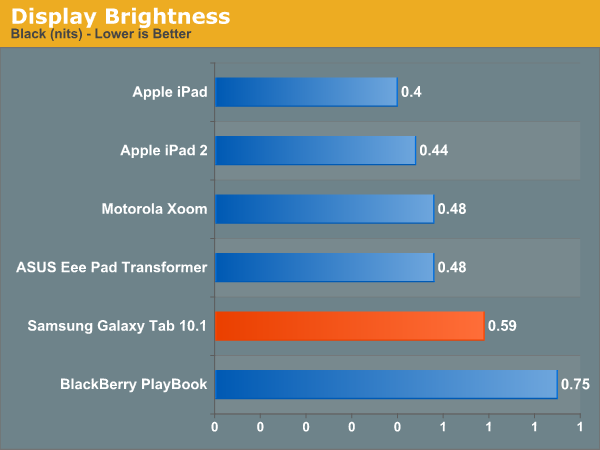
The higher black levels balance out the brighter panel and deliver a contrast ratio comparable to that of the iPad 2:
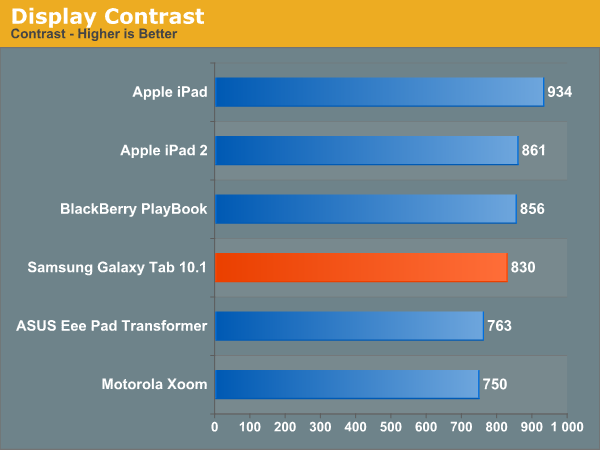
I should mention that the quality of the panel on the retail 10.1 sample is significantly better than what I saw with Samsung's Galaxy Tab 10.1 Limited Edition at Google IO. The sample from IO had noticeably worse black levels, lower peak brightness and as a result lower overall contrast. On top of all of that, the LE suffered light bleed from one of its corners - a problem I haven't seen on the retail 10.1. With only two Galaxy Tabs to compare this is either an indication of wildly varying quality control, or more likely that Samsung simply repackaged its early samples as LEs and saved the mass production hardware for paying customers a month after Google IO.
As you can see in the shot above the Samsung panel has a considerably cooler white point than the Eee Pad Transformer. A quick measure with our colorimeter shows a white point of 8762 (vs 7805K for the Eee Pad). It does make Samsung's default wallpaper look very pretty. If you're wondering, the iPad 2's panel is calibrated to a 6801K white point - at least with our 16GB CDMA sample here.


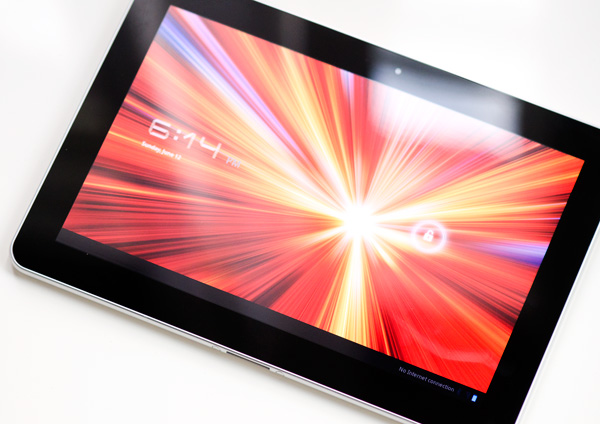
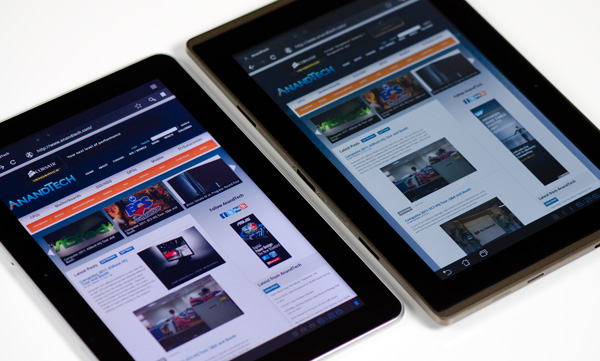








108 Comments
View All Comments
headbox - Monday, June 13, 2011 - link
With specs like those, I bet Samsung sells hundreds of these!Omid.M - Monday, June 13, 2011 - link
If they sold hundreds, they'd probably shoot themselves. I think you mean hundreds of THOUSANDS :)Good review, Anand, but I think this tablet is unfortunately another stop-gap: I think the true Android tablet will be 8.9" form factor and based off Kal-El, and hopefully in LTE form.
Hardware wise, I don't see much advantage of an iPad 2 over the Tab 10.1, so it boils down to ecosystem and UI philosophy (Honeycomb vs iOS). Well, and SDK; Brian and I have had a brief chat about this :)
-Omid
@moids
bplewis24 - Monday, June 13, 2011 - link
I believe the OP was making a point about the lack of consumer interest in android tablets right now, no matter how good they are.MonkeyPaw - Monday, June 13, 2011 - link
I think its a lack of awareness. iPad. Is just all people know, and its well marketed compared to Android tablets. I have impressed many people with the capabilities of my Nook running CM7. Either people aren't convinced of the value of android tabs, or they are too heavily associating them with cell carriers. They might not think they can be purchased outside of a contract. That, or its hard to beat apple marketing.bplewis24 - Monday, June 13, 2011 - link
I agree on both counts. The mainstream tech media has played a part in this as well as Apple's own marketing. The bottom line is that Anandtech is one of the few tech sites to give Honeycomb tablets positive reviews.KoolAidMan1 - Monday, June 13, 2011 - link
This is really the first one that has deserved positive reviews. The Xoom in particular was garbage. Honeycomb hardware is finally getting there in terms of displays and physical form factor. Once the Tegra 3 gets into Android tablets later this year the hardware will finally give legit competition to the iPad 2.B3an - Monday, June 13, 2011 - link
What are you talking about?Tegra 3 Android tablets wont be competitive with iPad 2 hardware wise, they will be considerably superior.
These Android tablets right now, like the Galaxy Tab 10.1 are already more than competitive on hardware. The Tab 10.1 has twice as much RAM, a better screen, and also higher resolution. The only real area where iPad 2 is unquestionably better is it's GPU. But thats about it. Overall the Tab 10.1 wins on hardware.
KoolAidMan1 - Tuesday, June 14, 2011 - link
Legitimate competition means being superior to the iPad hardware, not as good as or worse than. Otherwise there isn't much point give the app selection and excellent hardware you get with the current iPad. Right now it is a wash or considerably slower, especially when it comes to the GPU as you pointed out.Not hating btw, this is objective reality. I think that the conclusion of the article is correct: if you are on the fence then one should wait. The Xoom was terrible, and while the Transformer and Galaxy 10.1 are huge improvements, the real Honeycomb tablets worth getting excited about will be out later this year once Tegra 3 is in them. That and more developers on board is when we'll see real competition in the tablet space.
PeteH - Tuesday, June 14, 2011 - link
I think it's also worth pointing out that GPU is probably more important to most people's tablet experience than anything else in the silicon.So long as Apple's GPU performance continues to exceed what is available to other tablet manufacturers they will have a significant advantage. And since Apple effectively has more silicon available to it at a given price point compared to their competitors (they only have to pay to fab their chips, they don't have to pay a further markup to someone like NVIDIA) it could be very difficult for anyone to catch them in the near term.
The0ne - Thursday, June 16, 2011 - link
Sometimes I feel as though Android is the brother to Linux :) If it weren't for phones I think pads wouldn't have a chance. Android needs better and more marketing/PR so consumers are aware of them. My nephews own phones with Android but they'll go huh if you as they what OS. Ask an iPhone user and they immediately know because well, it's iphone :D